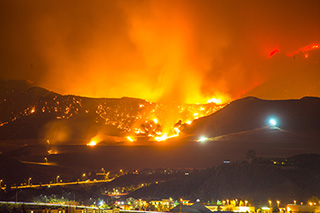November 15, 2022

SLevels of polycyclic aromatic hydrocarbons (PAHs) were higher inside homes than outdoors during certain wildfire conditions, according to researchers from the NIEHS-funded Environmental Health Sciences Core Center at Oregon State University. The findings may inform public health messaging regarding wildfires, which currently does not account for indoor air quality.
PAHs, a component of wildfire smoke, are associated with a range of adverse health effects, including some cancers, developmental and neurological issues, respiratory problems, and suppressed immune functions.
The study took place during the 2018-2020 wildfire seasons. The researchers worked with community members to deploy paired air samplers at 15 locations across four states – Washington, Oregon, California, and Idaho. At each spot, they placed one air sampler inside the home of a study participant and the second outside. Importantly, they collected data for vapor-phase PAHs, which current wildfire public health recommendations do not address.
Average outdoor PAH concentrations were 86 times higher during wildfires compared to before or after. Additionally, outdoor samplers detected 12 PAHs only during wildfires, revealing a unique wildfire-related PAH mixture for future study.
The team also compared outdoor and indoor PAH concentrations, discovering that indoor PAH levels were higher during certain wildfire conditions at more than half of sampled locations.
Using human health risk assessment methods, they found that inhaling vapor-phase PAHs during wildfires increased the risk of cancer and other health effects, regardless of indoor or outdoor location.
According to the authors, study results suggest that consideration of indoor air quality and vapor-phase PAHs is important for developing more comprehensive wildfire public health recommendations.
Read the publication to learn more.


